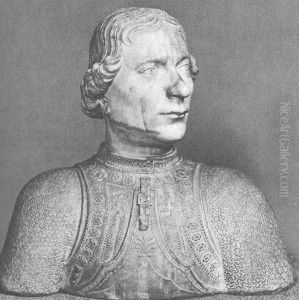Mino da Fiesole Paintings
Mino da Fiesole, born in Poppi near Florence in 1429, was a prominent Italian sculptor of the Renaissance. His work is renowned for its delicate craftsmanship and the elegance of its figures, reflecting the transition from the medieval to the early Renaissance style. Mino was initially trained in Florence, a city that was a crucible for the Renaissance's artistic innovations. Here, he was influenced by the works of Donatello and Desiderio da Settignano, which is evident in his fascination with the intricate details of human expressions and the subtle treatments of drapery.
Mino's career was marked by significant commissions that reflected his reputation across Italy. Among his notable works are the tombs he sculpted in the Badia Fiorentina and the Basilica di San Domenico in Fiesole, which showcase his mastery in creating harmonious compositions that blend architecture, sculpture, and epigraphy elegantly. His work on the tomb of Bishop Leonardo Salutati in Fiesole is particularly admired for its sophistication and the serene dignity it bestows on the figure of the bishop. Mino's ability to imbue his sculptures with a sense of gentle humanism is seen as a precursor to the high Renaissance style.
Despite the acclaim he received during his lifetime, Mino da Fiesole's work was somewhat overshadowed by the luminaries of the High Renaissance in later centuries. However, his contributions have been reassessed in recent years, highlighting his role in the development of Renaissance sculpture. Mino's talent for combining technical skill with emotional expression helped bridge the medieval and Renaissance periods, making him a significant figure in the history of Italian art. He died in Florence in 1484, leaving behind a legacy of work that continues to be appreciated for its grace and refined beauty.


